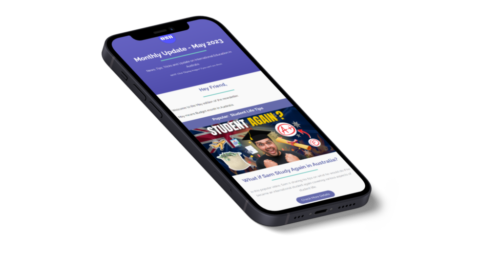Education System in Australia
Students in Australia are provided support to study collaboratively, learn new skills of problem-solving, communication, and lots of research using innovative ideas.
Regardless of the level of study, you are going to study, rest assured that you will be able to achieve your dream goals with Australian education.
As an international student, you can study from the age of 6 on a student visa in Australia albeit parents are making appropriate welfare arrangements. So it is important to understand each and every level of the education system in Australia.
Primarily, the Australian education system is divided into 3 main categories:
-
Primary Education
Kindergarten to Year 6
Age – 2 to 12 years
Kindergarten and Early childhood is a one to two year program which helps young ages kids to learn before they got to the school. Although it is not compulsory to attend young kids can develop social, physical and mental skills during these programs.
Primary school for most kids in Australia starts at the age of 4 to 5 and attending school is compulsory in Australia till the age of 15 to 17 depending on the state and territory. There are lots of public (government funded) and private schools available for the students. The curriculum in the schools are usually set by the government and everyone needs to follow this curriculum.
-
Secondary/ Senior Secondary Education
Year 7 to Year 12
Age – 12 to 18 years
Secondary and Senior Secondary education usually runs for 5 to 7 years depending on the state or territory students are living in. The secondary school runs from Year 7 to Year 10 while Senior Secondary runs from Year 11 to Year 12.
All schools will need to follow the guidelines/curriculum given by the government in their state and territory. However, the curriculum does provide flexibility in regards to the syllabus being covered.
After completing Year 12 successfully, students will get a certificate which is known as Senior Secondary Certificate of Education. Some students will decide to study vocational education and so will go on to university after completing Year 12.
-
Tertiary Education
Tertiary education in Australia includes vocational education and training and university.
Vocational Education and Training
Certificate I to Advanced Diploma
Age – 18+ years
Students who would like to get hands on training and would like to do vocational training than university will either study at TAFE or private education providers . This includes:
- Certificates I to IV
- Diploma,
- Advanced Diploma
While the timeframe for completing each certificate (I to IV) range from 3 months to 12 months, Diploma and Advanced Diploma can be completed from 6 months to 2 years.
These courses can provide students with a pathway to university or help directly entering the workforce. There are a range of vocational courses students can choose to study. Some of them are:
- Agriculture
- Business
- Childcare
- Construction
- Hospitality
- Information Technology
- Manufacturing
- Mining
- Retail
University
Bachelor Degree, Master Degree and PhD
Ages – 18+ years
University is the highest level of education in Australia. There are 43 universities in Australia out of which 40 are public universities and the rest of them are private. Universities usually offer various programs that provide professional knowledge to the students.
There are three main levels of education at the University:
- Undergraduate (Bachelor Degrees)
- Postgraduate (Masters Degree)
- Doctoral (PhD Degree)
Students who have completed Year 12 or equivalent in their home country can get into admission in Undergraduate program as long as they meet the minimum admission requirements (e.g. English Language Tests).
Students can enrol into Postgraduate programs after completing undergraduate program from a university in Australia or from the country you are applying from.
In order to get into Doctoral programs, students will need to have done a minimum of a Masters Degree with high grades, or Master Degree by research or Bachelor Degree with honours demonstrating high grades.
While students can complete a Bachelor Degree within 3 to 4 years, Masters Degree within 1 to 2 years and PhD within 1 to 2 years.
Pathway Programs
Many international students can’t get into university directly due to not meeting the minimum requirements of the undergraduate programs of the university.
So Pathway Programs also known as Foundation Courses are offered to support and assistance to those students and to prepare them to succeed in university.
These courses usually run for 1 year and at the successful completion of these courses, most of the students will get a place in the university. The timeframe of the course and getting a place in university can vary based on the individual student situation.
English Programs
Australia prides itself for the quality of its English programs run through various private institutes, TAFEs and universities.
If the students English is limited, then they could be advised to take an English course before the start of the formal study. This course is formally known as ELICOS (English Language Intensive Courses for Overseas Students)
These courses can run from 1 week to 72 weeks depending on the student’s English level. Students are required to meet the strict attendance requirement of 20 hours per week or they risk getting visa cancelled.
There are 4 main types of ELICOS courses international students can undertake in Australia:
- General English – Designed to improve general English skills.
- English for Academic Purposes (EAP) – Designed to prepare students for further studies.
- English for Specific Purposes (ESP) – Designed to improve the English in a specific field or area.
- Exam Preparation – Designed to prepare students to undertake globally recognised test like IELTS, Cambridge Certification, etc.
Australian Qualifications Framework
Australian Qualifications Framework (AQF) is a policy that was designed in 1995 for regulated qualifications in the Australian education and training industry.
The purpose of AQF is to define the level of each qualification delivered in Australia and create a national standardised system where students have a clear pathway to follow as one qualification level leads to the next level.
Regardless of which college, TAFE or university students choose in Australia, there will be no difference between the education levels and the qualification titles. All students completing nationally recognised qualification must have a Unique Student Identifier (USI).
The 10 levels of the Australian Qualifications Framework are:
- Certificate I
- Certificate II
- Certificate III
- Certificate IV
- Diploma
- Advanced Diploma/ Associate Degree
- Bachelor Degree
- Bachelor with Honours/ Graduate Certificate/ Graduate Diploma
- Master Degree
- Doctoral Degree
Grading System
Each level of study has its own grading system, It is also interesting to know that every state, territory, institute and university can have their own grading systems.
While most of the schools, Tafe and universities have grading system along with the percentage, where students are awarded a grade based on their performance. Most of the vocational education system in Australia is based on competency rather than grades.
If you would like to see how the grading system works at various levels in Australia, we have got a complete guide on it. Check it out here.

